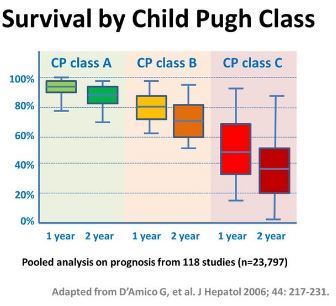Alcoholic liver cirrhosis treated by 1,000 IU of vitamin D
Vitamin D supplementation in patients with alcoholic liver cirrhosis: a prospective study.
Minerva Med. 2018 Jul 2. doi: 10.23736/S0026-4806.18.05723-3. [Epub ahead of print]
Savić Ž1, Vračarić V1, Milić N2, Nićiforović D3, Damjanov D1, Pellicano R4, Medić-Stojanoska M5, Abenavoli L6.
 50% chance of survival for 1 year with Score C (unless get vitamin D)
---
1. See also VitaminDWiki
* Overview Liver and vitamin D
* Search for Fatty Liver in VitaminDWiki 627 items June 2018
* Search for CIRRHOSIS in VitaminDWiki 361 items July 2018
* Advanced liver cirrhosis death 6.3X more likely if extremely low vitamin D – Jan 2013
* The worse the chronic liver disease, the lower the vitamin D level – Review Dec 2012
* Liver and interactions with vitamin D deficiency - Review July 2013
* Loading dose greatly improves subsequent daily Vitamin D if have liver fibrosis – RCT Nov 2016
* Cirrhosis infection and death both associated with low vitamin D – June 2015
*
50% chance of survival for 1 year with Score C (unless get vitamin D)
---
1. See also VitaminDWiki
* Overview Liver and vitamin D
* Search for Fatty Liver in VitaminDWiki 627 items June 2018
* Search for CIRRHOSIS in VitaminDWiki 361 items July 2018
* Advanced liver cirrhosis death 6.3X more likely if extremely low vitamin D – Jan 2013
* The worse the chronic liver disease, the lower the vitamin D level – Review Dec 2012
* Liver and interactions with vitamin D deficiency - Review July 2013
* Loading dose greatly improves subsequent daily Vitamin D if have liver fibrosis – RCT Nov 2016
* Cirrhosis infection and death both associated with low vitamin D – June 2015
* 
BACKGROUND:
The liver is involved in the metabolism of vitamin D. The prevalence of osteopenia in alcoholic liver disease (ALD) patients is between 34-48%, and the prevalence of osteoporosis is between 11-36%. Advanced liver disease is considered a risk factor for osteoporosis development. Aim of our study was to establish the relationship between vitamin D level and Child-Pugh score in patients with alcoholic liver cirrhosis (ALC), and to evaluate the effects of oral vitamin D supplementation.
METHODS:
The clinical and laboratory data of seventy male patients, with ALC, in absence of active alcohol intake were enrolled. A supplementation of cholecalciferol 1000 IU/day was administered. The vitamin D status was analyzed during the study, in patients stratified by Child-Pugh score.
RESULTS:
The study was completed by fifty patients. At the enrollment, the mean level of vitamin D was 60.73±28.02, 50.53±39.52 and 26.71±12.81 nmol/l, respectively for Child-Pugh score class A, B and C. During vitamin D supplementation it was found in all the patients a significant increased of its levels during the first six months (p<0.05). However, in class C the improvement was consistent also after year (p <0.05). A the end of the study, two of seven patients initially in class C changed in class A, four from class C to B, and one remained in class C (p=0.012). Out of seventeen patients initially in class B, eleven change in class A, and six remained in class B.
CONCLUSIONS:
In patients with ALC, higher level of vitamin D level is related with lower Child-Pugh score. The supplementation of 1000 IU/day of vitamin D in these patients was optimal for a period of at least six months. We found also a decrease of Child-Pugh score, with a redistribution of the patients in the different classes.
